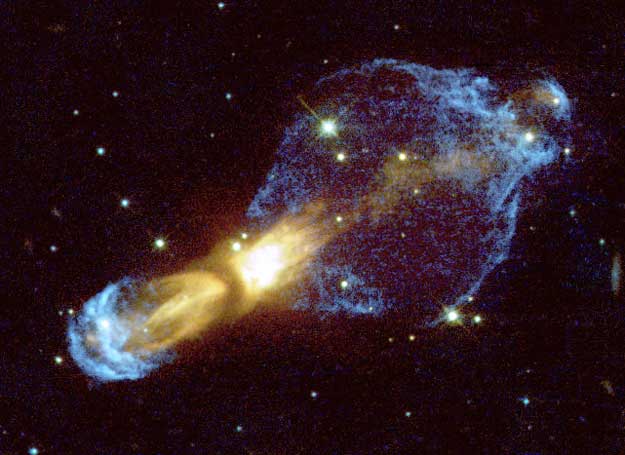Explanation: Fast expanding gas clouds mark the end for a central star in the Rotten Egg Nebula. The once-normal star has run out of nuclear fuel, causing the central regions to contract into a white dwarf. Some of the liberated energy causes the outer envelope of the star to expand. In this case, the result is a photogenic proto- planetary nebula. As the million-kilometer per hour gas rams into the surrounding interstellar gas, a supersonic shock front forms where ionized hydrogen and nitrogen glow blue. The complex shock front had been hypothesized previously but never so clearly imaged. Thick gas and dust hide the dying central star. The Rotten Egg Nebula, also known as the Calabash Nebula and OH231.8+4.2, will likely develop into a full bipolar planetary nebula over the next 1000 years. The nebula, pictured above, is about 1.4 light-years in extent and located about 5000 light-years away toward the constellation of Puppis.
1999 2000 2001 2002 2003 2004 2005 2006 2007 2008 2009 2010 2011 2012 2013 2014 2015 2016 2017 2018 2019 2020 2021 2022 2023 2024 2025 |
Yanvar' Fevral' Mart Aprel' Mai Iyun' Iyul' Avgust Sentyabr' Oktyabr' Noyabr' Dekabr' |
NASA Web Site Statements, Warnings, and Disclaimers
NASA Official: Jay Norris. Specific rights apply.
A service of: LHEA at NASA / GSFC
& Michigan Tech. U.
|
Publikacii s klyuchevymi slovami:
Planetarnaya tumannost' - planetary nebula - Rotten Egg Nebula - tumannost' Yaico
Publikacii so slovami: Planetarnaya tumannost' - planetary nebula - Rotten Egg Nebula - tumannost' Yaico | |
Sm. takzhe:
Vse publikacii na tu zhe temu >> | |
